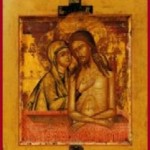stavrotheotokion. If we look at this compound word and break it down to its component parts we can recognize a couple of fairly familiar Greek words, Stavro – Greek for cross and Theoto(kos), the Mother of God. Now, we can connect the concepts The Theotokos and the Cross. The Stavrotheotokion is a troparion (short hymn with a theme usually sung after a verse of psalm), which is a manifestation of true human emotion. It is a poetic expression of the pain, sorrow and astonishment of a mother beholding her Son and her God on the Cross. These verses of theology and tenderness are heard in many of the services of the Great Lent, but reach their zenith in the services of the Holy Passion. The Theotokos expresses the wonder of us all. The awe, which could only be articulated by a mother who has kept a secret for many years (“and his mother kept all these things in her heart” Luke 2, 51). The identity of her Son as the incarnate God was known the Theotokos since the Annunciation. Now she suffers a new mystery, the inscrutability of her Son and Creator taking on death by His own free choice. Each of these verses proclaims the truth of Christ’s condescension.
[caption id="attachment_299" align="alignleft" width="150" caption="The Lament of the Virgin"] [/caption]
[/caption]
…”Woe is me beloved Child, light of my eyes! Thou has hung the earth above the waters, how can you endure to be nailed upon the Tree between two evildoers.” – Vespers of Tuesday in the Third Week.
None the less, the Virgin stands by the cross, hour by hour true to her mission to intercede for the entire world. Her pain is palpable. Her lament is moving and yet there is true nobility in her devotion. When all the disciples, except John the Beloved, had fled because of their fear, she and the other women stood there unafraid. St. Romanos the Melodist has captured her grief and her consolation in a kontakion (a combination of troparia of the same structure, connect alphabetically or acrostically) used on Great and Holy Friday. This dialogue between the Theotokos and her Son becomes the revelation of God’s plan of salvation in poetry. This kontakion is lyrical theology, stavrotheotokion with the voice of response by our Crucified Lord. Christ assures the Theotokos just as she witnesses his hanging on the Cross, she would receive this grace. [caption id="attachment_302" align="alignright" width="91" caption="The Theotokos at the Cross"] [/caption]
“Courage, Mother because you will see me first on my coming first from the tombs. I am coming to show you by how many toils I ransomed Adam and how much I sweated for his sake. I shall show it to my friends by showing the marks in my hands and then you will see Eve, Mother, living as before, and you will cry out with joy: ‘He has saved my forebears, my Son and my God.’*
*(St. Romanos the Melodist. On the Life of Christ: Kontakia. Translated by Archimandrite Ephrem Lash. Edited by Kerry Brown, The Sacred Literature Series. New York et al.: HarperCollins Publishers, 1995, p. 148).]]>
[/caption]
“Courage, Mother because you will see me first on my coming first from the tombs. I am coming to show you by how many toils I ransomed Adam and how much I sweated for his sake. I shall show it to my friends by showing the marks in my hands and then you will see Eve, Mother, living as before, and you will cry out with joy: ‘He has saved my forebears, my Son and my God.’*
*(St. Romanos the Melodist. On the Life of Christ: Kontakia. Translated by Archimandrite Ephrem Lash. Edited by Kerry Brown, The Sacred Literature Series. New York et al.: HarperCollins Publishers, 1995, p. 148).]]>
